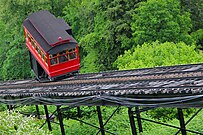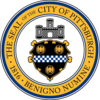
Pittsburgh
Second-most populous city in Pennsylvania, United States / From Wikipedia, the free encyclopedia
Dear Wikiwand AI, let's keep it short by simply answering these key questions:
Can you list the top facts and stats about Pittsburgh, Pennsylvania?
Summarize this article for a 10 year old
Pittsburgh (/ˈpɪtsbɜːrɡ/ PITS-burg) is a city in the Commonwealth of Pennsylvania and the county seat of Allegheny County. It is the second-most populous city in Pennsylvania after Philadelphia and the 68th-most populous city in the U.S., with a population of 302,971 as of the 2020 census. The city anchors the Pittsburgh metropolitan area of Western Pennsylvania. Its population of 2.457 million is the largest in both the Ohio Valley and Appalachia, the second-largest in Pennsylvania, the 7th-largest in the Mid-Atlantic region and the 26th-largest in the U.S. Pittsburgh is the principal city of the greater Pittsburgh–Weirton–Steubenville combined statistical area which includes parts of Ohio and West Virginia.
Pittsburgh | |
|---|---|
| Nicknames: | |
| Motto: Benigno Numine ("With the benevolent deity") | |
| Coordinates: 40°26′23″N 79°58′35″W | |
| Country | United States |
| State | Pennsylvania |
| County | Allegheny
|
| Historic empires | |
| Historic colonies | |
| Founded | November 27, 1758; 265 years ago (1758-11-27) (fort) |
| Municipal incorporation |
|
| Founded by |
|
| Named for | William Pitt the Elder |
| Government | |
| • Type | Mayor-council |
| • Mayor | Ed Gainey (D) |
| • City Council | List
|
| Area | |
| • City | 58.35 sq mi (151.12 km2) |
| • Land | 55.38 sq mi (143.42 km2) |
| • Water | 2.97 sq mi (7.70 km2) |
| Highest elevation | 1,370 ft (420 m) |
| Lowest elevation | 710 ft (220 m) |
| Population | |
| • City | 302,971 |
| • Rank | 68th in the United States 2nd in Pennsylvania |
| • Density | 5,471.26/sq mi (2,112.47/km2) |
| • Urban | 1,745,039 (US: 30th) |
| • Urban density | 1,924.7/sq mi (743.1/km2) |
| • Metro | 2,457,000 (US: 26th) |
| Demonym(s) | Pittsburgher, Yinzer |
| GDP | |
| • Pittsburgh (MSA) | $153.3 billion (2022) |
| Time zone | UTC−5 (Eastern Standard Time) |
| • Summer (DST) | UTC−4 (Eastern Daylight Time) |
| ZIP Code | 35 total ZIP codes:
|
| Area codes | 412, 724, 878 |
| FIPS code | 42-61000 |
| GNIS feature ID | 1213644 |
| Website | pittsburghpa |
| Designated | 1946[6] |
Pittsburgh is located in southwest Pennsylvania at the confluence of the Allegheny River and the Monongahela River, which combine to form the Ohio River.[7] It developed as a vital link of the Atlantic coast and Midwest, as the mineral-rich Allegheny Mountains led to the region being contested by the French and British Empires, Virginians, Whiskey Rebels, and Civil War raiders.[8]
Pittsburgh is known as "the Steel City" for its dominant role in the history of the U.S. steel industry.[9] For part of the 20th century, Pittsburgh was behind only New York City and Chicago in corporate headquarters employment; it had the most U.S. stockholders per capita.[10] Deindustrialization in the late 20th century resulted in massive layoffs among blue-collar workers as steel and other heavy industries declined, coinciding with several Pittsburgh-based corporations moving out of the city.[11] However, the city divested from steel and, since the 1990s, Pittsburgh has focused its energies on the healthcare, education, and technology industries.[12][13]
Pittsburgh is home to large medical providers, including the University of Pittsburgh Medical Center, Allegheny Health Network, and 68 colleges and universities, including research and development leaders Carnegie Mellon University and the University of Pittsburgh.[14] The area has served as the federal agency headquarters for cyber defense, software engineering, robotics, energy research, and the nuclear navy.[15] In the private sector, Pittsburgh-based PNC is the nation's fifth-largest bank, and the city is home to eight Fortune 500 companies and seven of the largest 300 U.S. law firms. Other corporations that have regional headquarters and offices have helped Pittsburgh become the sixth-best area for U.S. job growth.[16] Furthermore, the region is a hub for Leadership in Energy and Environmental Design and energy extraction.[17]
Pittsburgh is sometimes called the "City of Bridges" for its 446 bridges.[18] Its rich industrial history left the area with renowned cultural institutions, including the Carnegie Museums of Pittsburgh, Pittsburgh Parks Conservancy, Pittsburgh Zoo & Aquarium, Phipps Conservatory and Botanical Gardens, the National Aviary, and a diverse cultural district.[19] The city's major league professional sports teams include the Pittsburgh Steelers, Pittsburgh Penguins, and Pittsburgh Pirates. Pittsburgh is additionally where Jehovah's Witnesses traces its earliest origins, and was the host of the 2009 G20 Pittsburgh summit.















